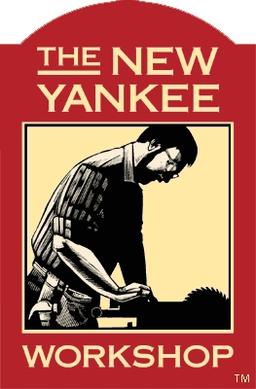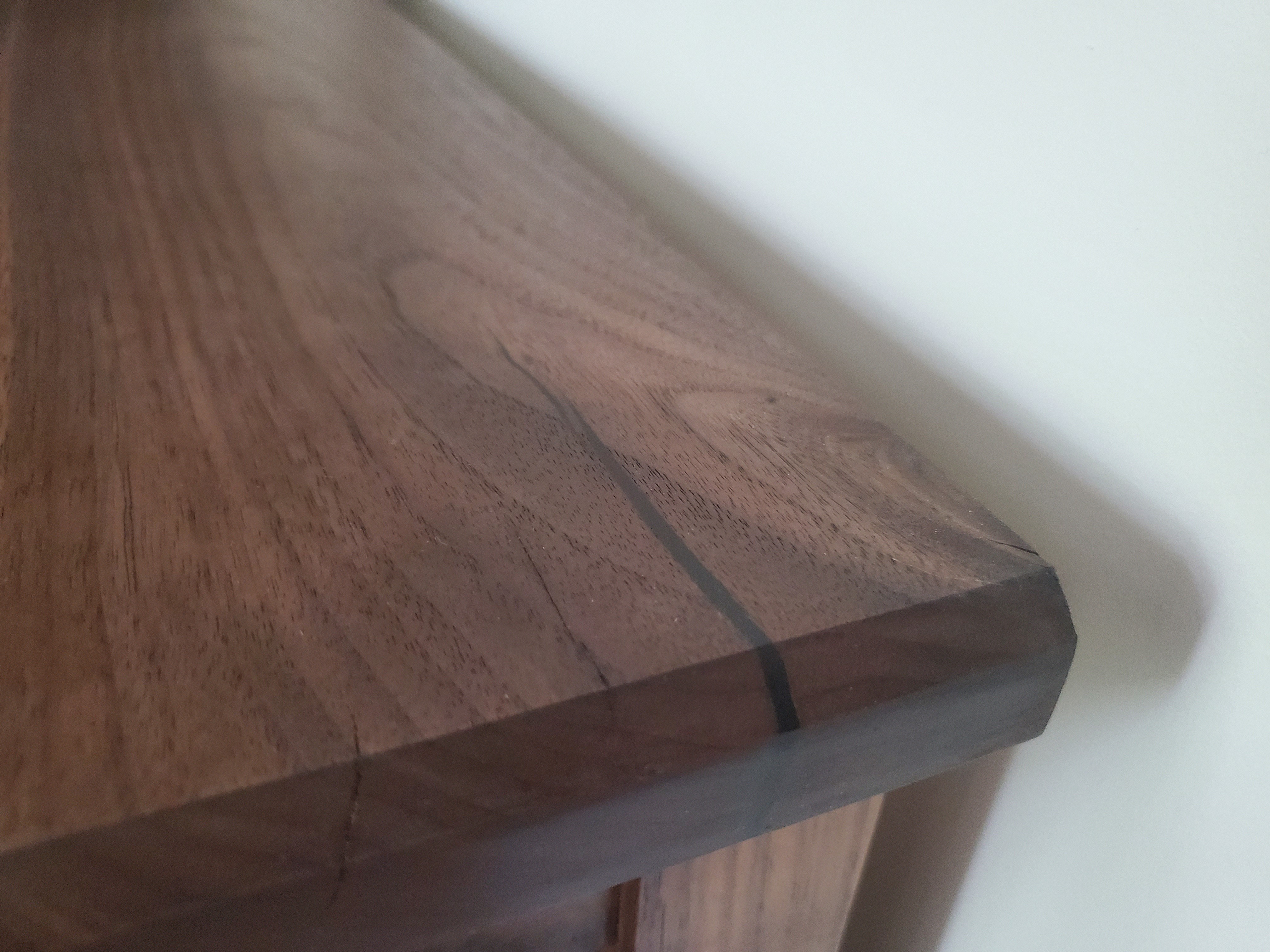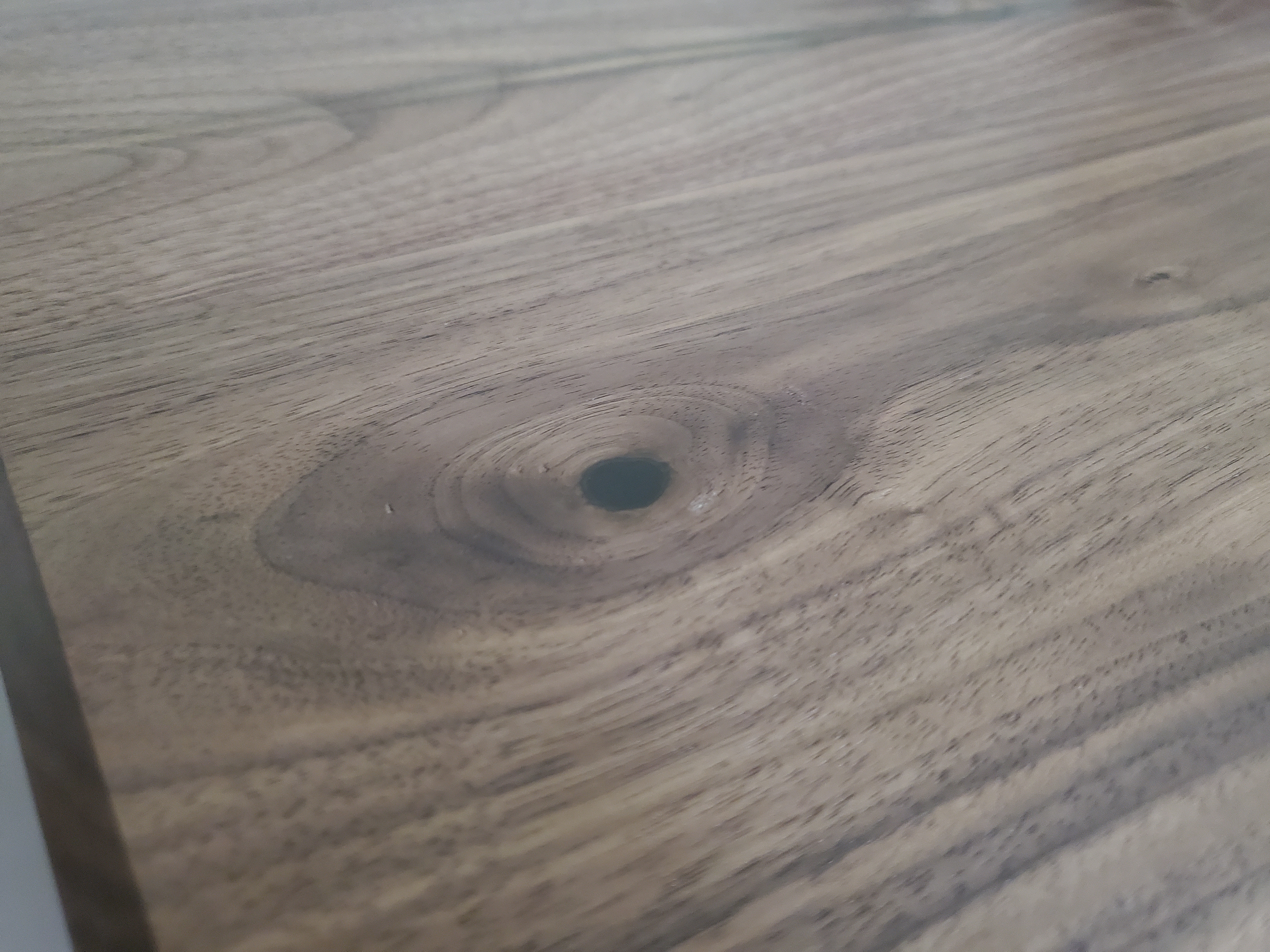

results:


Linux gamer, retired aviator, profanity enthusiast


results:




I have done pretty much exactly this very recently.
For some knot holes and cracks in the tops of the walnut cabinets I’ve recently posted about, I used System3 Mirrorcast. It’s a 2:1 volume mix, it comes in a 1.5 quart size, and it’s a crystal clear casting resin “Designed to fill knots, cracks and voids with minimal shrinkage.” Freshly mixed it has the viscosity of maple syrup or so, maybe a little thinner, it will self-level, and wicks into cracks.
I dyed mine black using their CastFX colorant which is designed specifically for their casting resins. In the pot it looked a little translucent but once in the wood it’s just inky black, looks great against the walnut.
The one downside it has, it takes forever to cure. The TDS claims a 1 hour working time and I think it’s actually longer. It takes 7 days to fully cure, and it remains thin and flowing for several hours after the pour. It can wick into wood.
If you can get a paintbrush into the void you’re filling, I suggest mixing a small batch, waiting a good 15 to 30 minutes, then painting it on the surfaces of the void to be filled. Let that cure for a good 12 to 24 hours, and then doing the full pour. Again, when doing the full pour, mix up the batch, and then just let it sit in the pot for half an hour.
Make sure the upper surface of the board is level to gravity. Pour it so that it just slightly protrudes above the surface under surface tension. A cabinet scraper is about the best tool for leveling it with the surface once it’s cured. As you sand it, it’ll take on a grey scratchy appearance, but it’ll look clear (or black) again when you apply finish. I can confirm it urethanes well.
^ Winner of the thread.
Torvalds, looking at Linux From Scratch like “Bish please.”


How the hell are we down to two meaningful web engines and two meaningful search engines?
There’s Firefox and everyone else, and everyone else uses Chrome.
There’s Google and everyone else, and everyone else uses Bing.


I agree, a machine for doxing people in general is misanthropist, a machine for doxing men specifically is misandrist.


The article linked above asserts that it was a “legacy portion” of the database that got leaked, and that all the leaked data is from February 2024 and earlier. So this vulnerability apparently existed for at least 18 months. The timing of the leak coincides with a spike in popularity which brought wider attention down on it, and finally someone without the desire to implicitly trust it gave it a look.
Which says to me that in the few years this app has existed, it was never scrutinized, not by anyone on the dev side and not by anyone on the user side. That’s fascinating to me.


I was today years old when I learned that Ashley Madison is still in operation


Yeah, and the US Marshall’s service said Operation Flagship was just a football sweepstakes.


Pretty sure it’s a nose ring.
I felt like I was doing alright. That week I had been promoted to project manager, I was working at a prototyping firm making all manner of stuff. I was taking on interesting projects, learning lots of new stuff. There are products I developed for sale on Amazon right now, hell some of them have probably been ripped off and are on Temu or Aliexpress by now. There are things I built on four continents. Barack Obama was president, my nation had a future, and I still owned a motorcycle.


Yahoo still exists. Somehow. Apparently the brand is extremely popular in Japan, Yahoo Japan is on the list of top 50 visited websites. IIRC the brand was bought by Verizon, and I have no idea if Yahoo even offers web search anymore.


Probably the closest to “Mac without a concussion” would probably be ElementaryOS with the Pantheon desktop, but I don’t really recommend it.
Linux is modular in ways you’re probably not used to. Windows looks like WIndows and that’s it, you can’t just uninstall the taskbar and install someone else’s taskbar. In Linux you can do pretty much exactly that. The GUI is a separate system that sits on top of the OS like Windows ran on top of DOS back in the 90’s and at airports today. There are several Desktop Environments (DEs) you can choose from.
For example, if you go to Linux Mint’s website, you will find it offered in three main flavors: Cinnamon, MATE and xfce.
The vast majority of DEs you’ll find in Linux are set up out of the box the way Windows is, in terms of basic UI elements. Most have a panel at the bottom with the application menu on the left, a window list next to that or centered, and system tasks and the clock on the right. A window has the minimize, maximize and close button at the top right, etc. Stuff you have muscle memory of using.
Gnome deliberately does things like that differently I think out of a sense of grudge. I used to hear Linux newcomers say things like “I tried Linux for a few hours and found you can’t even rename a file. Like it’s impossible to rename a file. Linux is completely useless.” And I didn’t understand how it was they could come to such a bafflingly dumb conclusion until I tried using Gnome and caught myself saying the same things.
Gnome also deliberately doesn’t implement a lot of features because they expect you to use the terminal for them. Other DEs like Cinnamon and KDE are actually finished.


I don’t know, I find it kind of fun to make a bit of a mess. Wouldn’t mind if it was a biologically inert mess.


Do they even still issue them? Like prior to ~2007 Hotmail was THE free email to have before Google, like, did it better. But aren’t they issuing outlook.com addresses now?


Went farther than Ranger 1 did.




Mainly I would steer you away from any distro that uses Gnome. Very short answer as to why: most desktop environments bear some resemblance to Windows, Gnome is more like MacOS with a concussion.


And the stereo, quieter or louder than the ass end of a 727?
I can think of a few reasons not to use a single 6" slab from the middle of the tree.